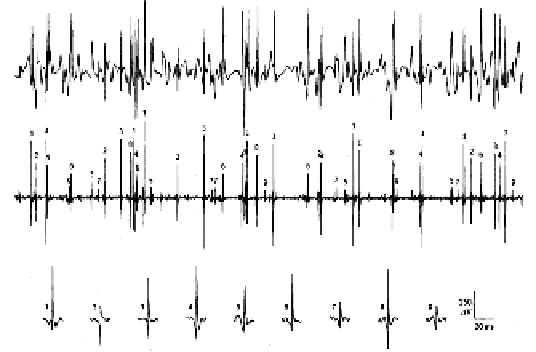Biomedical Engineering Reference
In-Depth Information
FIGURE 4.53:
Illustration of MUAP identification by ADEMG. From the top:
EMG signal, high-pass filtered signal, identified MUAPs shapes. From [McGill et al.,
1985].
A program called ADEMG for extracting MUAPs from the EMG interference pat-
tern for clinical diagnosis purposes was designed by McGill and coworkers [McGill
et al., 1985]. The signal processing consisted of four steps: 1) EMG signal was digi-
tally filtered to transform sharp rising edges into narrow spikes, 2) the spikes which
exceeded a certain detection threshold were classified by a one-pass template match-
ing method that automatically recognized and formed templates, 3) each tentatively
identified train of MUAPs was verified by examining its firing rate, 4) the MUAPs
corresponding to the verified spike trains were averaged from the raw signal using
the identified spikes as triggers.
The conversion of MUAPs to spike trains was motivated by the fact that the spikes
are better distinguishable than the MUAPs themselves, due to suppression of low-
frequency noise, and can be reliably detected by a simple threshold crossing detector.
ADMG in the last step of its operation adjusted the simple averages to cancel out
possible interference from other MUAPs.
Figure 4.52
shows the flowchart of the
ADEMG program and Figure4.53 illustrates the extraction of single MUAPs.
In the system designed by Stashuk [Stashuk, 1999] MUAPs were identified by
a similar procedure as in [McGill et al., 1985]. MUAP detection was followed by
clustering and supervised classification procedures in which the shape and firing
pattern of motor units were considered. The fraction of correctly detected MUAPS
was reported as 89% and the maximum false detections rate was 2.5%.
The ADMG system was further developed into an interactive EMG decomposi-
tion program EMGLAB [McGill et al., 2005], which can handle single- or multi-
channel signals recorded by needle or fine-wire electrodes during low and mod-
erate levels of muscle contraction. EMGLAB is a MATLAB program for viewing
EMG signals, decomposing them into MUAP trains, and averaging MUAP wave-







Search WWH ::

Custom Search